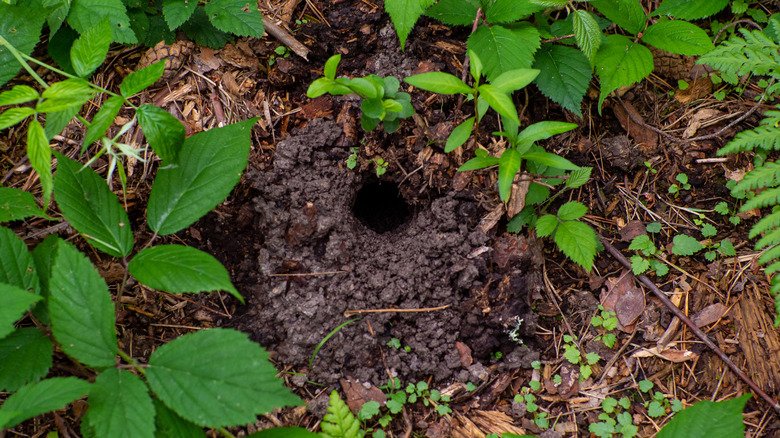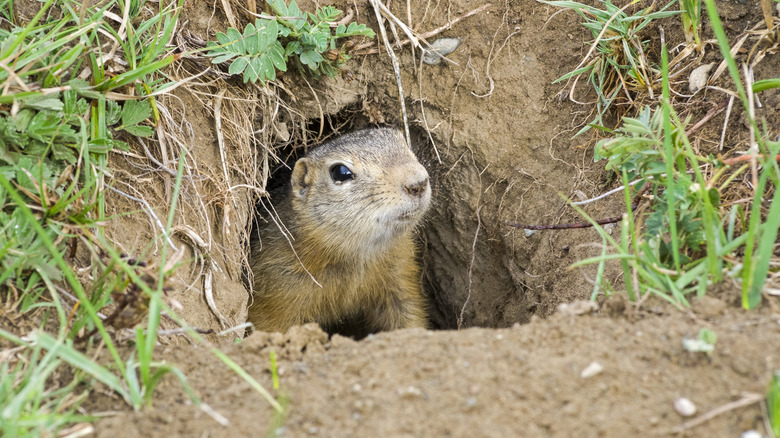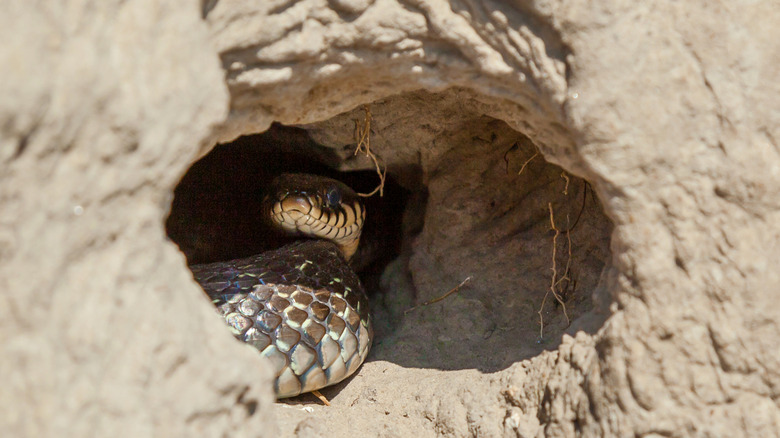Here's How To Figure Out Whether You Have A Snake Hole Or A Squirrel Hole In Your Yard
Finding holes in your yard can be frustrating, and squirrels don't care if it's an out-of-the-way spot or the middle of your pristine lawn. However, that hole could be hiding another inhabitant: a snake. Before you decide how to deal with them, you need to know who your unwelcome guest is. You need to be careful, too. While the majority of U.S. snakes are harmless, there are half a dozen types you definitely don't want to see in your yard.
So, being able to recognize one hole from the other at a safe distance is important. You'd think it would be easy. After all, although some types of ground squirrels are quite small, in general, you'd expect them to be fatter than most snakes. Logically, you would think that the biggest difference between a squirrel and a snake hole would be its diameter.
Unfortunately, there's a problem here. Snakes don't actually dig their own holes. Instead, they take over one that's already there, and that means any holes in your yard can encourage snakes to take up residence. To find out who is really hiding in the dark, you need a few more details.
Squirrel hole vs snake hole: the details you need to look for
Unless you're going to grab a cup of your favorite beverage and keep a vigil until a head pops out, you need to look for clues. If there's no depth to the hole and it's more of an indentation, it may just be where a tree squirrel has stashed its food. It's when you see deeper holes that things become more challenging.
If it's 3 inches or less across, it could well be a squirrel or other rodent. Squirrels usually dig quite tidy holes, but you might see claw marks in the dirt. You could also see food debris, such as bits of fruit or seed husks, around the entrance. Ground squirrels live in their burrows, so it's likely the network has multiple entry/exit points. However, without clear signs, you need to be careful. It could be a former squirrel home, now with a more dangerous occupant.
Snakes use holes to hide from potential predators, manage their body temperature, and ambush food. You might see wavy tracks near the hole, and the entrance itself could be smooth. Discarded snake skins are a sure sign, as are the remains of their dinner: bits of insect bodies, small bones, or rodent fur. Proceed with caution. Never stick your hand down a hole, and don't go poking it with a stick. If you think the inhabitant might be venomous, then the best course of action is to get a wildlife removal expert to take a look.
How to deter these invaders from living in your yard
Whether you have the burrowing or tree-dwelling variety, there are plenty of ways to get rid of squirrels. Bear in mind, though, it's never a one-and-done process. You might want to consider whether it's worth the effort. Sure, they can be a nuisance sometimes, but both tree squirrels and ground squirrels can also bring benefits into your yard, such as providing it with natural fertilizer, and they are great fun to watch.
Keeping snakes out can be a challenge. In addition to holes, they can live in stone walls and cracks in concrete in your foundations, paths, or driveways. Filling gaps as soon as you find them is always a good idea. For holes in the garden, try adding gravel to the dirt. It makes it difficult for the snake to get past, but it won't harm squirrels if you got the wrong culprit, because they'll be able to dig their way out.
It's also a good idea to keep grass short where possible, which reduces the places snakes can hide and makes them easier to spot if they are around. You can also introduce snake-repellent plants. There are more of these than you might imagine. Many of them are attractive, and several are edible.


